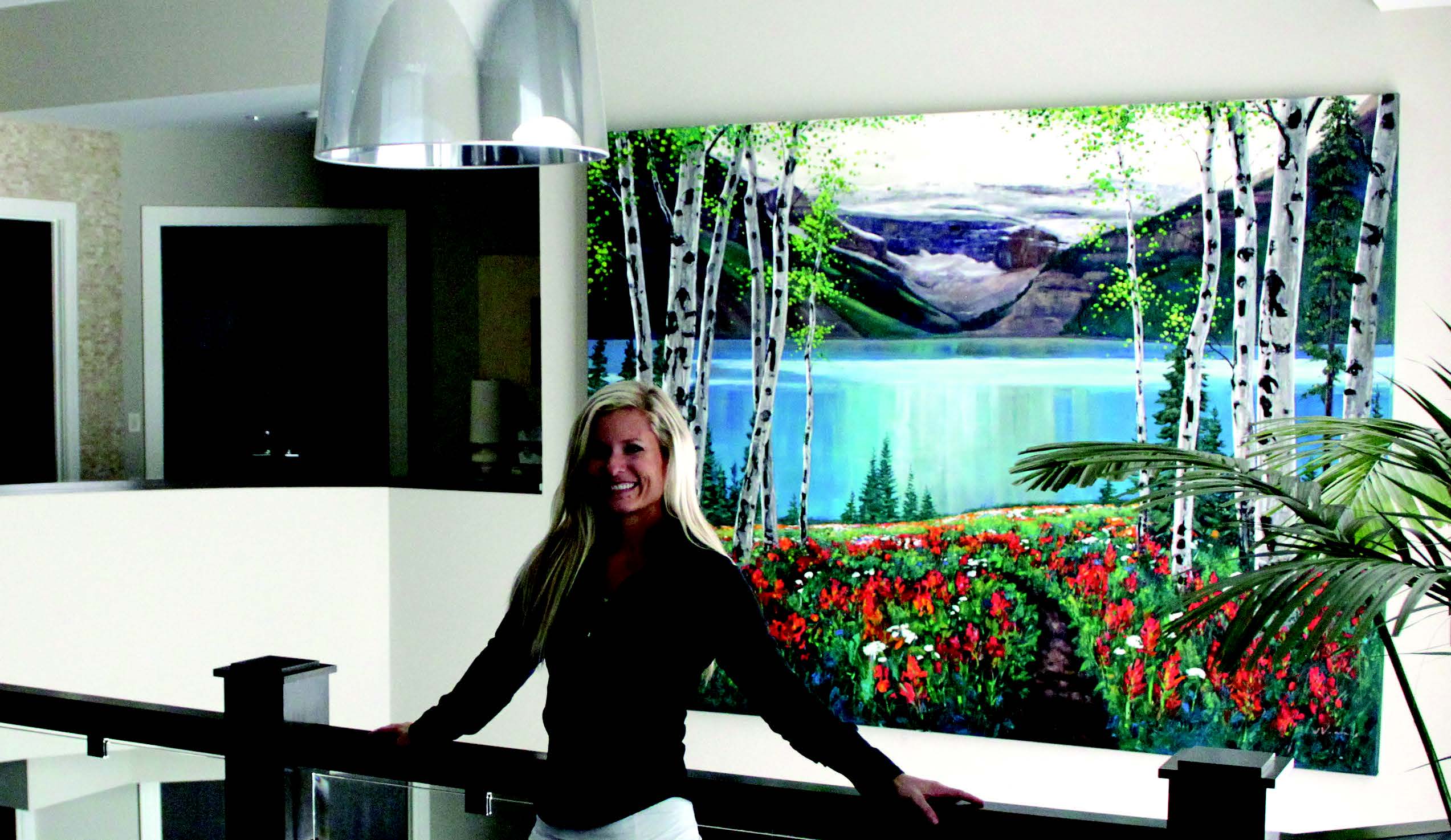The delicate dance of working for hire
by Kevin Canfield
About five years ago Jivan Lee (JivanLee.com) decided to create a painting of a home in Mamaroneck, New York. “Just for fun, I was painting the entrance of where I was staying at the time, which was my sister’s house,” Lee recalls. “A neighbor saw that and was like, ‘Oh man, would you do that for me?’ And that was it.”
That was Lee’s first time working as a commission artist. Though at first he didn’t find the neighbor’s place terribly interesting, he agreed to give it a shot.
“In this case the house was just not beautiful to me in the way I would be compelled to paint something,” says the New Mexico-based artist. “But I spent an hour or so just sitting there, looking at everything. I found what was compelling to me and I made a painting around that. In this particular case there was a beautiful tree right in front of this house that cast a shadow across the entire thing, and that shadow really was what made it possible for me to be inspired while painting.”
Lee’s experience is not unusual. Artists who make a living painting commissioned pieces—or those, like Lee, who supplement their income with the occasional commissioned work—are often faced with a unique set of questions: How does my artistic vision mesh with the desires of the client? What kind of input should clients have as I’m painting? And how much input? Every artist has different answers to these queries.
Robbi Firestone, a Tacoma, Washington-based artist who creates what she calls “Spirit Capture Portraits”—these, she says, “focus on one’s outer likeness and inner beauty”—has been doing commission work for eight years. Her paintings are inspired by impressionism, and these days, she says, 95 percent of her professional work is commission-based.
Once she has been hired to create a painting, Firestone interviews the customer “about their passions and their possibilities. Usually when people are becoming familiar with my work, I ask them to spend some time on my Website (RobbiFirestone.com) and really get to know my work, because I’m not a photorealist or classical realism artist. I have my own style.”
Firestone charges $15,000 to $20,000 per portrait—more than 20 percent of which goes to charity, she says—but on at least one occasion she told a potential customer that she wasn’t the artist for the job. “I just started asking him about his aesthetic and he seemed a little uncomfortable, so I ended up recommending him to another artist in the region because I could just tell my work wasn’t Pacific Northwest enough for him.”
Though she passed on that particular job, Firestone says she was happy to send a bit of work to another painter: “I’m really happy to support other artists. I feel like a rising tide lifts all boats.”
Federico Leon de la Vega, a Nayarit, Mexico-based artist who specializes in large paintings of fruit—oranges and tangerines are among his most popular subjects—and Pacific Coast seascapes, says his Website (FedericoLeondelaVega.com) is a useful marketing tool but adds that he gets a lot of commission work from diners who see his paintings in his wife’s restaurant.
Not too long ago “an elderly couple came and they had a couple of hamburgers and some coffee and stayed a long time,” says de la Vega. “You could tell that they were still in love after many years. They came into the gallery (next to the restaurant) and he just asked, ‘Would you do a portrait of my wife?’ I said I’d be delighted. That’s the way it happens most of the time.”
Like Firestone, de la Vega gets a sense of what his customers are looking for by doing preliminary sketches and color studies. Though he has never had to turn away a customer, de la Vega—who charges about $7,000 for a 5′ x 7′ fruit painting—admits that not every job is as compelling as the next. “Some commissions are more difficult to get inspired [for] than others,” he says, “but I definitely have to get inspired in everything I do. I try to find beauty in everything that I put my brush to.”
A native of Argentina who moved to the United States as a boy in the 1970s, Gino Savarino (SavarinoArt.com) paints professionally in Chicago, where he often works on commissioned pieces for private collectors, architects and interior designers. His commission work also includes performances in which he paints for groups of spectators. Savarino calls himself a modern abstract artist who works with “lots of texture and color” and whose style dictates the kinds of questions he asks potential customers.
“With abstract, it is different than a portrait painter or landscape work because the outcome is almost never what you expected it to be coming into the project,” says Savarino, who charges anywhere from $300 for a small painting to $3,000 for a larger work. “They have some sort of an idea of what my style is, and they will in turn say, ‘I’m looking for this size and these colors and I want it to have lots of texture.’ For me, that’s simple; that comes naturally. When they want certain shapes or [for the piece] to look a certain way, I try my best to accommodate them. But because it is abstract it’s sometimes almost impossible to create exactly what they’re looking for. Although I allow up to three revisions, it is always best [for clients] to give me a basic idea of what they’re looking for and allow me to just create.”
Recently Savarino had to explain to a potential customer that he just wasn’t the right artist for a particular job. “A bride-to-be wanted me to do a live painting performance with an abstract background, but she wanted the foreground to be her and her new husband doing their first dance. I told her, ‘Although I welcome new challenges, I cannot compromise my work or my style.’ If it’s not what I do, the best thing for me to do is what I did in this case: To refer her to an artist colleague of mine that specializes in that.”
Jennifer Vranes (JensArt.com), an Oregon-based artist who specializes in large-scale landscape paintings that she calls “happy art” (with a laugh, she says she has been told that her work helps lower the blood pressure of its viewers) has found herself in a similar situation only once since she began painting commission work in the late 1990s. “These people just wanted a copy, and I don’t want to do a copy of anything,” she says. “It’s always unique and original.”
Customers typically provide Vranes—who completed approximately 50 commissioned paintings last year—with furniture swatches and information about wall colors as she’s working. “Sometimes they’re really specific: ‘Can I get this painting in this size?’ And I’ll say, ‘Every painting is unique, but it can be very similar and it can be done in any size you need.’”
“If you want to make a living and create art for other people’s homes, then you need to be flexible,” Vranes continues. “I’m not the one living with it, they are.”
Lee says he has never had to turn away a potential customer, but notes that commissions (he has done seven, for which he charges up to $12,000, over the last few years) are just a small part of his working life.
Asked what he would do if he was faced with a customer who wanted a painting that he was unmoved to create, Lee answers that he has “been lucky enough that I haven’t had to face that question, knock on wood. I hope I don’t really ever have to face the question of, ‘Am I going to modify my artistic approach to meet a collector’s demand?’ I think in that case I would just say, ‘Why are you commissioning the work from me? Find an artist who’s going to actually paint something with passion that you want to see.’”
Firestone agrees, adding that artists who believe they can provide what customers are looking for shouldn’t hesitate to join the ranks of those who work on commissioned pieces.
“My advice to artists is that if you can get someone to hire you for a commission, then do it and see how it goes for your own personal self-discovery,” she says. “We judge ourselves so much, and we limit ourselves so much. So much of our identity is placed on how much money we make as artists, and I feel like the sooner you can open that pipeline to being comfortable with making money from your artwork, the better it is.
“I know great artists who are just terrified to do a studio tour,” Firestone continues, “or are terrified to post how much they charge on Facebook. Artists have to be brazen. You have to jump off the cliff —you have to put yourself out there.”
About the Author:
Kevin Canfield is a freelance writer living in New York City. His work has appeared in the New York Times, the Los Angeles Times, Spin, Bookforum, Film Comment and many other publications.









NO COMMENT